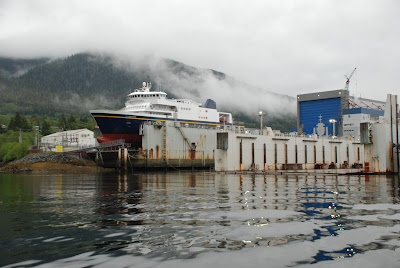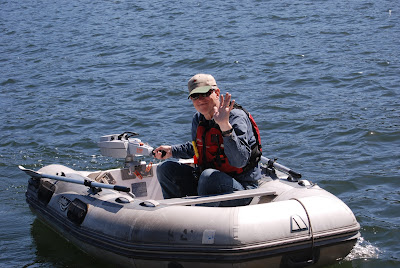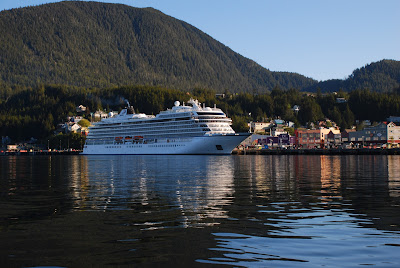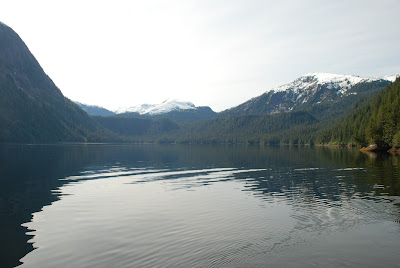Memorial Day weekend has traditionally been sort of the official start of the summer boating and sport fishing season. In past years, when I was much younger, the 3-day Memorial Day weekend was the first weekend of the annual King Salmon Derby.
Of course, in those years I was working full time, sometimes at 2 jobs, and had a wife and young children at home. The chance to be out on the water and "escape" was always looked forward to. In hindsight I think the fishing aspect was somewhat secondary to just being out on the water.
In those days I didn't have a boat big enough to stay out on, so we just fished during the days. The Derby at that time stopped accepting fish to be weighed in at 9 PM, so we would typically fish right up until 9 PM, and then head for the dock, sometimes not getting home until 10 or 11 PM. Then of course we'd be up bright and early ready to go fishing again for another day. I recall being totally exhausted but continuing to go out and fish.
Now, the king salmon stocks are depleted, and the Alaska Department of Fish and Game has put numerous restrictions in place. They are somewhat complex and I'm not even sure what they are at this point. But I do know that the King Salmon Derby has been canceled for this year as it has been for the last couple of years. I read in the paper that they are going to stage a Silver Salmon Derby early in September instead.
The weather forecast for the 3 days starting Saturday was excellent, so I decided to make a 3-day trip out of it.
I pulled out of Bar Harbor a little after 6 AM on Saturday morning. Right away I noticed that the large catamaran Melinda Leigh was sort of shadowing me as I motored slowly out of town.
These boats are large catamarans used for running tourists from the cruise ships back into Misty Fiords. Back in the early days of tourism they used to use much slower boats and it resulted in something like a 12-hour ordeal to go back into Misty Fiords and back in a single day. It was exhausting for the tourists, and many slept for most of the way. Nowadays they use these fast catamarans that run at about 30 knots. In addition, they also do a "fly/boat" combo where the tourists take the boat out there and then fly back on a float plane, or vice versa, fly out and take a boat back. It makes for a much more enjoyable experience for the tourists.
At first I couldn't figure out why a tourist boat would be in this part of Tongass Narrows and going in this direction. Then I finally figured it out. While I was out of town for 3 years in Gig Harbor they built a cruise ship docking facility in Ward Cove. This boat was headed in there to pick up tourists for their Misty Fiords experience.
On the way out of town I also passed the Alaska Marine Highway System facility. Among other vessels there, the ferry Columbia was tied up there. I read in the paper that the AMHS is in desperate need of employees. I think the article said they needed some huge number, like 750 or 1000 employees, to be fully staffed. The Columbia is actually out of service directly due to not having enough crew to run her for the summer season.
I also passed the Vigor shipyard, where they haul, build, and repair vessels of all sizes. They have 2 sinking haul-out areas where they sink the whole thing, and the ship moves in. Then they place keel blocks under it and then refloat it, raising the ship in the process. It's an amazing process. They work on all kinds of vessels. This morning the Alaska State Trooper vessel Stimson was tied up there after recently being hauled out for maintenance.
The Vigor shipyard has their own pleasure boat that I assume is used for employees and guests of the company. It's a beautiful boat, about 45' in length. And of course it's name is "Vigorous."
On my way out into Western Behm Canal I had to pass over an area that I call a "halibut hole." No fishing spot is 100% predictable, but I have caught many halibut over the years on this spot. But, I have to say, I have also been skunked there on multiple occasions.
That's my boat approaching from the bottom, heading up. If you look at the numbers on the chart, they are depth readings, in feet. You can see that all around the depths are over 1000'. And then looking in the middle of the screen you can see that there is a small area where it is much shallower, all the way up to about 150'. The theory is that halibut like to come up from those depths and feed on these underwater plateaus. On this day the wind and current were just a little too brisk for me to drift fish and stay on this small spot, so I just proceeded on.
When I got up to Port Stewart the weather was just perfect so I stopped for a bit just in front of the entrance to try bottom fishing again. I really, really wanted to get just a small halibut for dinner. Here is a shot of the area just outside the entrance. I got no fish so just headed into the cove.
Port Stewart is shallow and fraught with hazards to navigation. But I had been in here before a time or two so I knew what to expect. This is a shot of my smaller GPS unit that I have at the lower helm station that shows the "skinny" part of the entrance where you have to weave your way past some rocks to get into the little nook where you can safely anchor.
I have a hard time envisioning the early sea faring explorers who had no access to such technology. They had to determine the depth by dropping a weighted line over the side.
I decided to make the effort and drop the raft into the water and do a little excursion. I had not used the raft since returning to Ketchikan from Gig Harbor. It is a little bit of work to get it lowered into the water, and then to put the little outboard motor onto it.
For many years I used a 4 HP Suzuki outboard motor on the raft. It weighed about 60 lbs. And since I stored it on the flybridge it took some effort to get it down and securely mounted on the transom of the raft. And it certainly didn't get any easier each year as I got older.
Back in 2016 I invested in an electric outboard. It is a Torqeedo, and is the equivalent of a 4 HP motor, but all electric. It comes apart into 3 components: the battery (the heaviest at about 10 lbs), the tiller, and the drive shaft itself with the propeller. It is very easy to move around, and much easier than the old Suzuki to mount onto the raft. It's not as fast as the Suzuki and the grand kids don't like it much because it doesn't go fast enough. But for running the dog to the beach or just putting around, it is fine. Here is an old photo from a previous trip that shows what it looks like.
There was not much to see in this little nook. But a man can never have too many pictures of his boat. There is a small cabin on the beach, and the remains of a few more are hidden in the brush, but I didn't go to shore on this trip to explore further.
Since I had the time and the raft was already prepared I went ahead and baited and dropped just 1 crab pot nearby. I always carry 2 pots with me at all times, but it had been awhile since I had the opportunity to use them.
In the morning when I pulled the pot there was one crab in it. In this area we can only keep males that are at least 6 1/2" wide. These are Dungeness crabs. This one was legal and since it had been some time since I had fresh crab I kept him.
Cooking him turned out to be more difficult than catching him. I usually use a propane cooker to cook my crab but I had neglected to bring any propane with me on this trip, so I had to use the little 2 burner electric stove in my galley. It is adequate for general cooking, but this task almost proved to be too much for it. It took about 45 minutes just to get the water to boil. Then after I put the crab in, it took almost an hour to reach a second boil. I will have propane on board for any future trips.
That night I watched a movie which I had checked out of the library. When I had the boat in the boat yard in Seattle from late 2015 to May 2016, one of the things I had done was a significant upgrade to the TV/stereo entertainment system. I had the TV itself replaced with a larger one, and a lot more speakers added. It is really a great system now and makes watching a movie on board a much better experience.
I had a peaceful night at anchor, however the anchor drag alarm kept going off even though the boat did not appear to be moving. When I am on the anchor overnight I always set an anchor drag alarm on my GPS unit. You set a distance, like 80' or 100', and if the boat moves more than that distance an alarm goes off. Eventually I got tired of getting up and resetting it so I just turned it off and went back to bed.
In the morning I was up early as usual but did not pull the anchor and leave until about 9:45 AM. It's not that I was being a sluggard. The entrance is pretty shallow and I did not want to leave until the tide came up enough to make departure a little easier.
I made my way northward up to Spacious Bay, stopping again a couple of times to try to get that elusive halibut for dinner. I didn't want much, just a small one would suffice. But nothing.
I have been in Spacious Bay a few times over the years, but it has been awhile since I was back there. I was surprised to see a cabin/house back in there now.
It looked like a nice setup, with 2 mooring buoys anchored out front. I did not see anyone moving about the area.
I got successfully anchored behind Square Island. Here are a few photos from my new temporary home.
I didn't put the raft in here because it was such a huge bay and my little electric kicker would probably not have enough "oomph" to get me all the way around it.
I took a shower and hung out on the boat keeping busy with guitar work, reading, cross words, etc. I always load up on Kindle books before setting out on a trip like this because I invariably end up with lots of cabin time on my hands.
In the evening I watched another movie that I got from the library. This one was "127 Hours," about the guy that had to cut off his own arm with his knife when he got it stuck in a boulder while on a remote wilderness hike. Yikes!
At one point in the evening I noticed a bunch of what I assume was some sort of pollen drifting around the boat. The engines were not running at the time or I would have been concerned about them sucking it up into the cooling system.
On Monday morning I seriously considered changing my original plan and staying out one more night. I really wanted to see that anchorage deep into the back of Yes Bay. But when I made a list of all the things I needed to do in town I decided to take a long slow ride back to town, stop to fish along the way, and plan on arriving into the harbor about 8:30 or 9 PM. I still had hopes of getting a halibut somewhere along the way.
I started out slow, letting the engines warm up before putting much load on them. I had one of the side panels on the flybridge enclosure open to allow for air flow since it gets pretty hot up there when it is sunny. After over 3300 hours of running this boat I have become attune to its sounds, and I soon noticed something out of the ordinary. I could not immediately put my finger on it, so listened more intently. Soon I figured that I had dolphins alongside, and the sounds I was hearing was their breathing when they hit the surface and the water splashing around as they weaved in and out in front of the bow wave and alongside.
I put the boat on auto-pilot and leaned out the side where the panel was open trying to get photos. Video would have been more suitable, and I am working on that. I was so frustrated with my camera. Sometimes it would just not fire when I pressed the button, and it's not like I could get the dolphins to pose for photos. They surfaced when they surfaced and I just hammered that shutter release and did the best I could.
They only stayed with me about 15 minutes, and then I guess got bored and moved on. Fun to see though.
As I approached Traitors Cove I decided to once again stop and try some bottom fishing. I still had not given up hope for a halibut. It was dead calm, and perfect conditions for drift fishing without anchoring.
It wasn't too long before I got a strong hit. Things can happen quickly on a boat. I started reeling it up, and had it about halfway up from 300' when I saw and heard a lone Killer Whale approaching the boat. There was no way I could leave the rod and grab for my camera, so the Killer Whale just cruised on by without my getting any photos.
By this time I had figured out that it probably was not a halibut, just from the way it fought, or didn't fight. Halibut fight all the time, all the way to the surface. I could feel the weight, so I knew it was a good fish, but it just didn't kick enough to be a halibut. When I got it up I saw that it was a pretty big Red Snapper.
In previous years this would be a no-brainer as a keeper. Red Snapper tastes great. However now they are protected, or endangered, or somehow restricted, so that we have to throw them back. Not only that, we have to attempt to release them at or near the depth where we caught them, in this case about 300'. They have an air bladder in them that expands as they get to the surface up into their gullets, due to the lower air pressure at the surface as compared to the pressure at 300'. The ADF&G says we have to use a deep water release mechanism and release them down there.
I have one but had never had the opportunity to use it. I had read the directions but was still uncertain about how to set it for the various depths. The one I have is pressure sensitive and is supposed to release the fish when the water pressure is great enough to trigger the release of the jaws holding the fish.
I rigged it up as best I could, trying to do it quickly since the fish was out of the water. You have to attach lead weights to it to drag the fish down to depth because with that air bladder in it inflated the fish has so much buoyancy that it floats.
I had the fish lowered about halfway down, when out of blue, (or out of the red) I got a nosebleed. So now I'm dripping blood all over the back deck, and it's not fish blood. The release must have worked because when I brought it back up the jaws were open and the fish was gone.
I decided to go around the outside of Tatoosh Rocks on the way home. I had not been out that way in awhile, and the weather was still perfect.
Along the way I passed the US Navy sub testing facility floating barges. Several years ago the Navy set up this facility for doing sonar testing on nuclear subs. They have a land based facility as well, but these are the 2 floating barges that they use for this. When a sub is actually in the area they put a notification in the paper. When they are actually doing a sonar testing run, which I understand takes several minutes, they do not want any extraneous sounds in the water. So boat travel in the area is restricted, and if you happen to be there anyway, they call you and direct you to stop your engines and go dead in the water until the testing is complete.
I proceeded on getting nearer to town. But I still did not have that halibut, so I decided to stop near Guard Islands and try some more bottom fishing.
Guard Islands marks the west entrance to Tongass Narrows with a light house. It used to be a manned station, with the light keeper and sometimes his family, living on the island. Now it is an automated facility. I read a book a while ago written by a woman who lived on Guard Island as a child as her father was the light keeper. She came through town on a cruise ship and chartered a boat to take her out there to see the island.
Once again, no halibut for me.
It was approaching dinner time and I still did not want to get back to town too early, so I decided to head over into Vallenor Bay where I could shut down the engines and drift while I cooked dinner.
It was quite beautiful back there, and still dead calm and sunny.
Here is a shot of a cruise ship that had just come out of Ketchikan and was proceeding in its voyage.























































